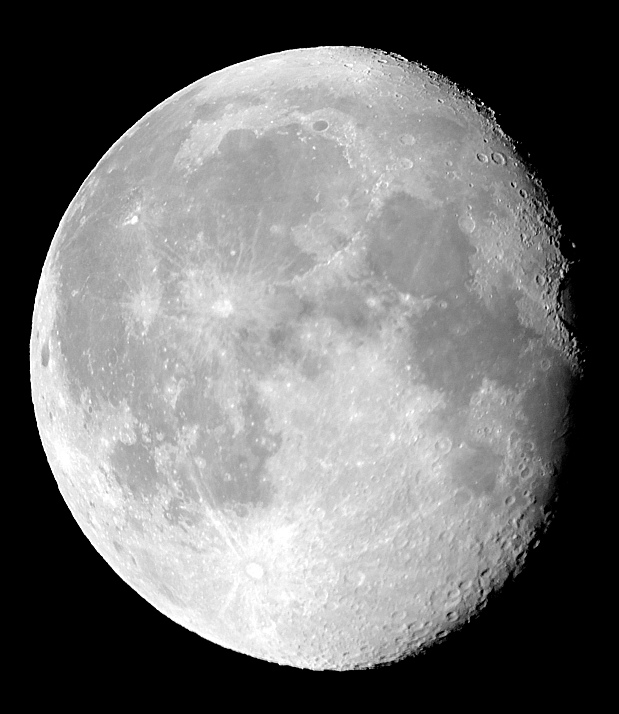
iPhone 5s: Moon, Mare Crisium
Posted: 22 October 2013
Cassiopeia Observatory was opened Monday, 21 October 2013, at 1807 MST, 78°F. The sky was clear. At 1812 MST, viewed Mercury, low in the western sky, 83X. Then briefly viewed Saturn, very low and mostly obscured by trees, 83X. Venus was much better, 83X, and was a nice view at 222X.
At 1841 MST, the Milky Way was visible. Astronomical Twilight would not end until 1906 MST. The waning gibbous moon would rise at 1946 MST. With Venus getting into a tree, I took my last look at it, 83X, at 1847 MST.
Beginning at 1907 MST, did some iPhone 5s compatibility tests of Dark Sky Meter Pro. Sent the results to the developer and the International Dark-Sky Association.
I returned to the 8" telescope and before the moon rose, I did the "Tonight's Best" AutoStar guided tour, 83X. Viewed the Double Cluster, double star Albireo, M13 (globular cluster), M22 (globular cluster), M34 (open cluster), M8 (Lagoon Nebula), M15 (globular cluster), M27 (Dumbbell Nebula), M2 (globular cluster), M20 (Trifid Nebula), M17 (Swan Nebula), M92 (globular cluster), M82 (galaxy), M81 (galaxy), M11 (Wild Duck Cluster), M57 (Ring Nebula), M31 (Andromeda Galaxy), M32 (galaxy), M110 (galaxy), M52 (open cluster), M16 (Eagle Nebula), Helix Nebula, Uranus, and Neptune. It is always nice to see old friends again. With the eastern sky brightening from the rising moon, ended the tour at 1946 MST.
At 2000 MST, I did some terrestrial viewing using the 2X nightscope.
At 2020 MST, slewed the 8" telescope to the moon's position, still behind the hill to the east. Beginning at 2029 MST, watched the moon rise over the hill, 83X. Mare Crisium was bisected by the terminator. It was fully visible on the previous night. At 2110 MST, while waiting for the moon to rise higher, did some more nightscope terrestrial viewing.
At 2131 MST, I took this iPhone 5s photograph (slightly cropped) of the moon, afocal 83X:

I then did a tour of the lunar terminator, 222X. Mare Crisium was definitely a nice view, showing some very nice shadows along the illuminated rim. I switched to 364X and did some more Mare Crisium viewing. This image, cropped from a "slo-mo" iPhone 5s video (120fps) frame, shows Mare Crisium and the rim shadows:

Compare the photo above to the one on the previous session.
Took a final look at the moon, 364X and 83X, at 2200 MST. Then began closing up for the night.
The observatory was closed at 2213 MST, 59°F.
Comments are welcome; use the Comments section below, or you can Email Me. Thanks.
Cassiopeia Observatory Home Page